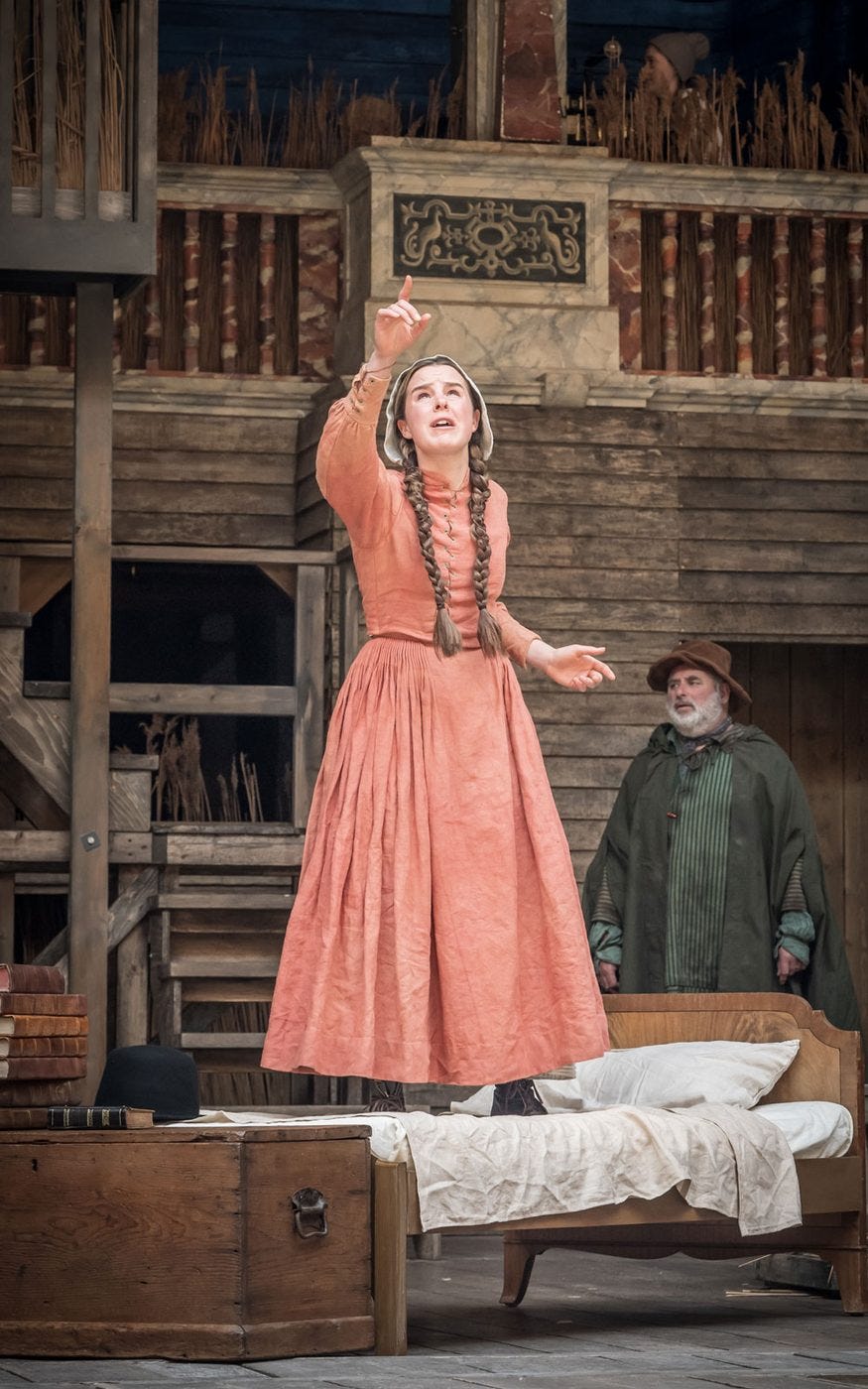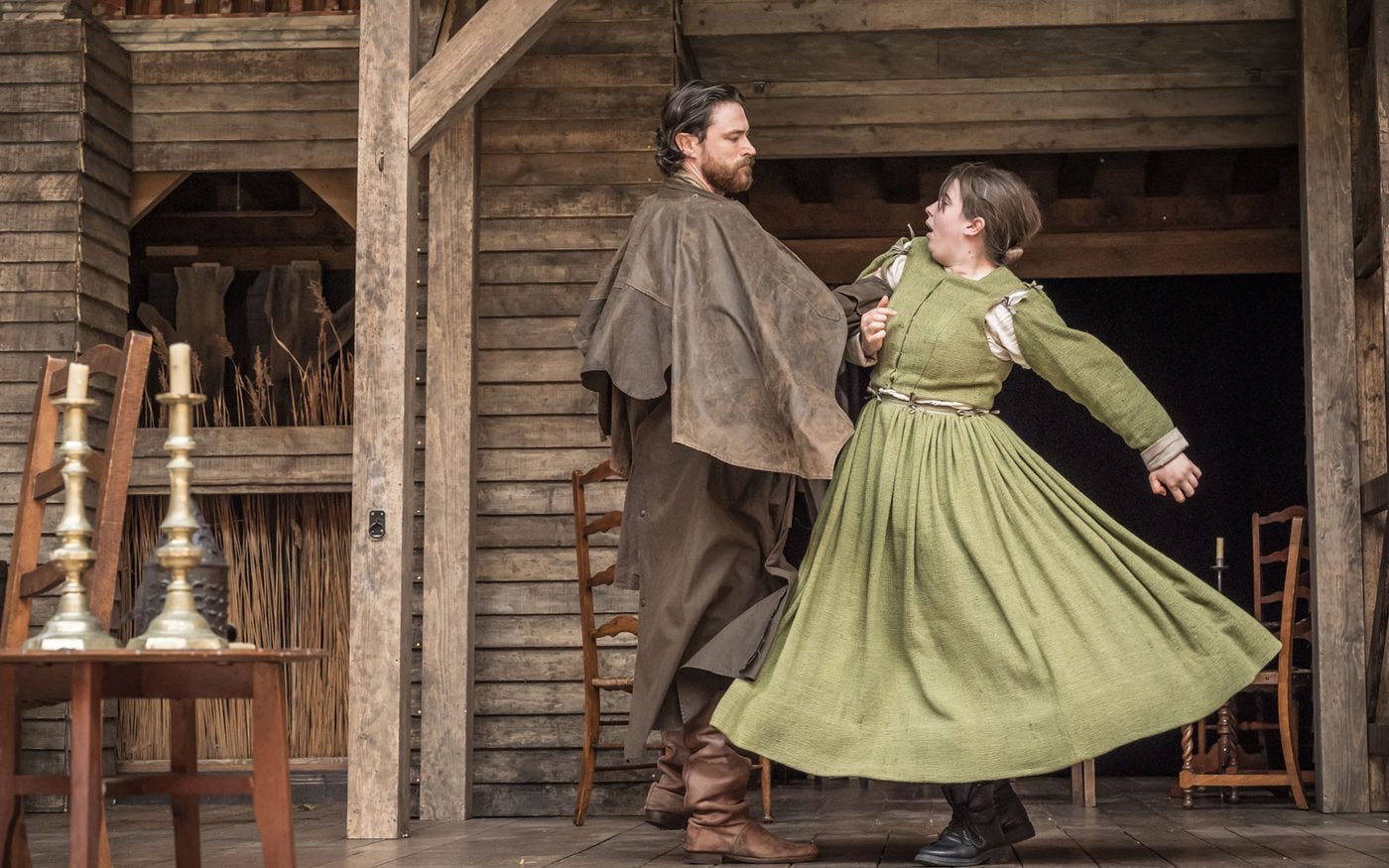Can a play about one of the most infamous witch hunts in history be played for laughs and if so, should it? A couple of weekends ago I went to see a production of Arthur Miller’s The Crucible at The Globe in London and it completely changed my opinion of the play and got me thinking about the use of humour in the cruellest plots.

More Weight
Arthur Miller’s The Crucible was originally produced in 1953 at the Martin Beck Theatre (now the Al Hirschfeld Theatre). It’s the story of the Salem witch trials which took place in Massachusetts between 1692-3 and saw over 200 people accused, nineteen of whom were hanged. A further five people died of disease in jail, and one man, a farmer called Giles Corey, came to a uniquely grisly end.
Corey knew that if he maintained his innocence he would likely face hanging when he was judged to be a witch. Falsely admitting guilt and feigning repentance might save his life, but it would mean that his property would be confiscated away from his family. Corey was a stubborn man, a ‘tough customer’ to put it mildly. Corey had already faced a murder charge for beating an indentured servant so viciously that the man had died from his wounds. Yet in the madness of the witch trials, this bullishness gave him a strangely brave resolve: he refused to plead either way and so was ‘pressed’ to death. ‘Pressing’ was a brutal torture (also called ‘Peine forte et dure’) where the victim lay beneath a board and large rocks or weights were loaded on top of them until they gave in or expired.
His last words when he was urged to comply are said to have been simply ‘more weight.’
This awful fate is described in the play, and we also watch several characters choosing to plead ‘innocent’ and go to the gallows rather than lie and risk their immortal souls.
So all in all, fairly weighty subject matter, if you’ll pardon the pun…
Gallows Humour at the Globe
Is there something funny about the absurdities of Salem? Even if you’re not familiar with the context of the Red Scare, it’s obvious that Miller isn’t just writing about Puritans and witches. The Crucible is about the ability of whole communities to become poisoned by a mass delusion or, more properly, by a folie à deux between neighbour and neighbour where everyone doubts yet everyone fears what will happen if they voice their doubt. We see these patterns all the time in social groups, just as we recognise the petty grievances of the community, the sexual jealousies, the resentments, the longstanding grudges about a will or a land boundary…

And it’s because of that familiarity that, in a good production, some of the details of the script becomes extremely funny. It seems that, in a theatre like The Globe, this humour can be much more easily activated.
Okay, tiny bit of theatre history. The Globe theatre (technically called ‘Shakespeare’s Globe’) is a recreation of an Elizabethan playhouse. The key details of its design that matter here are that it has a round shape with a stage that sticks out into the audience. People can stand in the ‘yard’ as ‘groundlings’ and literally lean on the edge of the stage. Actors can walk off and on through the audience and action can happen in the yard below the stage, particularly in crowd scenes.
This design has an alchemical ability to transform long and complex dramas spoken in verse into thrilling living stories and to turn the audience into active participants rather than concealed observers. If you’ve heard of the ‘fourth wall’ this is something that doesn’t exist in theatres like the Globe, the action isn’t set back as if behind a cinema screen or invisible ‘fourth wall,’ but happens in amongst the audience in the broad light of day.
The original 1953 production of The Crucible was set behind a fourth wall in what’s called a ‘proscenium arch’ theatre, so the effect was much more like peering voyeuristically through a window into a real moment in history. Both are powerful theatre designs, but with very different effects.
Compare this shot from the Martin Beck Theatre in 1953…
…to this photo from the 2025 Globe production.
Interestingly, when he reflected on the play’s legacy in a 1996 essay, Miller admitted that the premiere had not been well received, coming across as a ‘mechanical parable’ and a ‘history lesson.’ He preferred a production a year later which was ‘played with the fervor that the script and the times required.’ In the same essay, Miller discusses the exodus of American talent to Europe that had happened in the wake of the McCarthy hearings and mentions Sam Wanamaker ‘who would lead the successful campaign to rebuild the Old Globe Theatre on the Thames.’ I wonder whether Miller considered how The Crucible would communicate on such a stage where both ‘fervor’ and absurdity can thrive.
You are Somewhat Mentioned
Working with the special qualities of The Globe, director Ola Ince has done something daring and inspired with the 2025 production: she has let The Crucible be funny. Ince notices the humour in lines which I have elsewhere seen played with deadly seriousness to silence. In tiny moments, in little social frictions and revealing turns of phrase, the audience has been encouraged to laugh so that when the consequences of these petty tensions are revealed, we find them all the more upsetting. The challenging three hour run time passed breezily for me, even though I had a cheap ticket and was standing in the yard (like the peasant that I am).
For example, when the Reverend Hale arrives to adjudicate over the accusations, we get the following exchange:
He appears loaded down with half a dozen heavy books.
HALE: Pray you, someone take these!
PARRIS, delighted: Mr. Hale! Oh! it’s good to see you again! Taking some books My, they’re heavy!
HALE, setting down his books: They must be; they are weighted with authority.
That got a laugh in this production. Hale is a man who has swanned in with an air of easy superiority, believing in his own learned perceptiveness even though he is a total outsider with no real understanding of the nest of resentments in Salem. Just as he struggles to carry his books on his own, he will soon struggle with the burden of his new responsibility. Hale ultimately comes to regret his role in the trials.
And then we get our fraught domestic tragedy in Act II which can be played as a dreary dirge but has plenty of opportunities for bitter humour. John Proctor and his wife Elizabeth are still trying to get past his infidelity with Abigail Williams, the teenage girl who is at the heart of the witchcraft accusations. Elizabeth has guessed, correctly, that Abigail wants to weaponize the court against her and marry her husband after she is executed.
Their maid servant, Mary Warren, doesn’t make things better when she arrives home from a day in court.
Elizabeth, softly: I am accused?
Mary Warren, quaking: Somewhat mentioned.
This got a big laugh from the crowd. ‘Somewhat mentioned?’ imagine being ‘somewhat mentioned’ in a witch trial, this is hardly comforting to hear. Mary seems to dig the hole deeper with everything she says, caught between her loyalty to the other girls in Salem and to her mistress and master back home on the farm, a comically put-upon coward.
As they argue, there is a knock on the door. Guess who has turned up to question them? The same Mr Hale who found his books so heavy. He asks John to prove his godliness by reciting the ten commandments. Naturally, John forgets just one:
Proctor, counting on his finges: Thou shalt not steal. Thou shalt not covet thy neighbor’s goods, nor make unto thee any graven image. Thou shalt not take the name of the Lord in vain; thou shalt have no other gods before me. With some hesitation: Thou shalt remember the Sabbath Day and keep it holy. Pause. Then: Thou shalt honor thy father and mother. Thou shalt not bear false witness. He is stuck. He counts back on his fingers, knowing one is missing. Thou shalt not make unto thee any graven image.
Hale: You have said that twice, sir.
Proctor, lost: Aye. He is failing for it.
Elizabeth, delicately: Adultery, John.
Ouch. Awkward. There was a big intake of breath and some ‘oohs’ from the crowd at the Globe. Of all the bits of scripture for a straying husband to have forgotten, (or somehow suppressed)!
Then John tells Hale ‘you see, sir? Between the two of us we do know them all.’
Bitter laughter from the crowd. Nothing like a release of tension to make you realise just how tense you were.
During the courtroom scenes, the crowd dynamic encouraged by the architecture of The Globe really came into its own. The characters had already seemed like they were on trial before us, but now they literally were. Extra platforms in the yard meant that characters were displayed on chairs in the midst of us. A very Vincent Price-like Gareth Snook playing Deputy Governor Danforth pushed past us to get to the witnesses and called directly on us to observe and condemn the wickedness at work in Salem. The campy excess of his outrage raised laughter that immediately turned sour as the deadly consequences of the trial felt all the more inevitable.
And honestly? I think that all these moments made the production much sadder than other versions I have seen. The tragedy hit home because the audience had not been bored, had not trudged through the plot as if it was a funeral procession or a history lesson, but danced towards that horrid ending. The deadly silence, the tears in people’s eyes, the breathless anticipation of the final scene was all the more palpable because it formed a contrast with those earlier moments of relief.
I think Arthur Miller would have approved.
So the moral of the story is — well, don’t let your puritan uncle catch you dancing in the woods. But the secondary moral is that if you want to write a story about cruel and frightening realities and you want to make an audience feel as if they recognise these characters and empathise with them, if you don’t want to bore them, if you want them to cry, don’t be afraid to make them laugh.
Last week The Teletubbies and this week The Crucible. You never quite know what will happen in my Monday articles, but if you’re interested in the history of magic, horror, theatre, storytelling and the generally weird and wonderful, consider paying to subscribe to keep me writing or like, share, comment, and recommend for free to help my substack grown. My tip jar is here— thank you!









Thank you for your analysis of stagecraft and performance at Shakespeare's Globe. It has a special place in my heart, and the few times I've been there have never been dull. There was that time when I found out two middle school kids attending a performance of the Scottish play as part of a school trip pointing their phones toward the stage to play Pokemon Go during the interval. And there's always the jig to look forward to. If only I had world enough, airfare, and time!
Rebekah, this was an excellent analysis of the crucible. Although I was forced to read it for AP English, looking back on it (and after rereading it) I realized that yes, it is indeed hilarious.